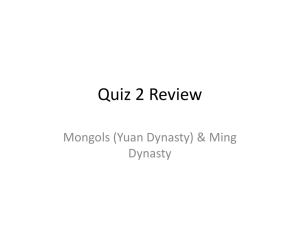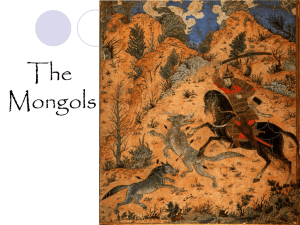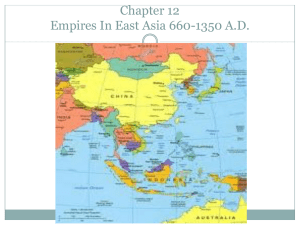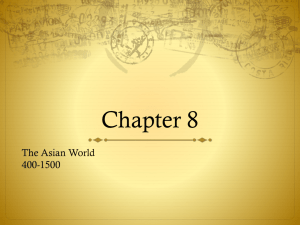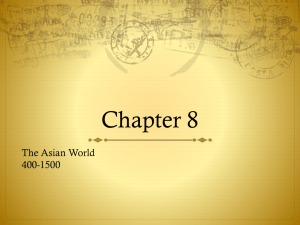KEY_china_japan reading guide
advertisement
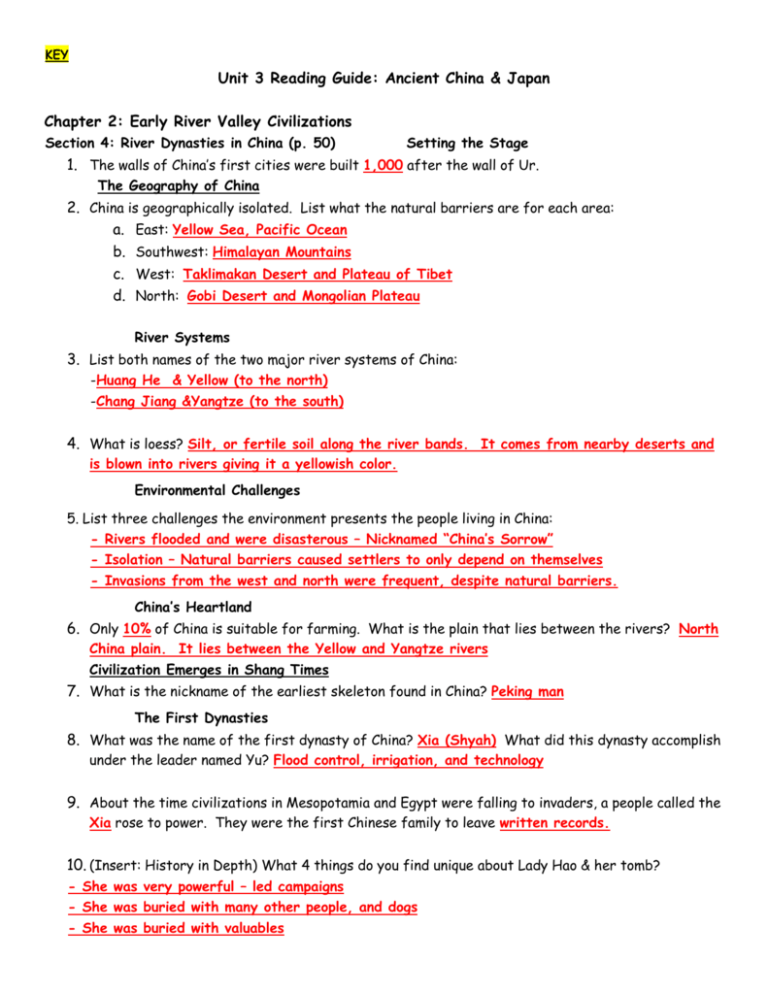
KEY Unit 3 Reading Guide: Ancient China & Japan Chapter 2: Early River Valley Civilizations Section 4: River Dynasties in China (p. 50) Setting the Stage 1. The walls of China’s first cities were built 1,000 after the wall of Ur. The Geography of China 2. China is geographically isolated. List what the natural barriers are for each area: a. East: Yellow Sea, Pacific Ocean b. Southwest: Himalayan Mountains c. West: Taklimakan Desert and Plateau of Tibet d. North: Gobi Desert and Mongolian Plateau River Systems 3. List both names of the two major river systems of China: -Huang He & Yellow (to the north) -Chang Jiang &Yangtze (to the south) 4. What is loess? Silt, or fertile soil along the river bands. It comes from nearby deserts and is blown into rivers giving it a yellowish color. Environmental Challenges 5. List three challenges the environment presents the people living in China: - Rivers flooded and were disasterous – Nicknamed “China’s Sorrow” - Isolation – Natural barriers caused settlers to only depend on themselves - Invasions from the west and north were frequent, despite natural barriers. China’s Heartland 6. Only 10% of China is suitable for farming. What is the plain that lies between the rivers? North China plain. It lies between the Yellow and Yangtze rivers Civilization Emerges in Shang Times 7. What is the nickname of the earliest skeleton found in China? Peking man The First Dynasties 8. What was the name of the first dynasty of China? Xia (Shyah) What did this dynasty accomplish under the leader named Yu? Flood control, irrigation, and technology 9. About the time civilizations in Mesopotamia and Egypt were falling to invaders, a people called the Xia rose to power. They were the first Chinese family to leave written records. 10. (Insert: History in Depth) What 4 things do you find unique about Lady Hao & her tomb? - She was very powerful – led campaigns - She was buried with many other people, and dogs - She was buried with valuables - She played the role of a male in terms of her power. The Development of Chinese Culture 11. Why did the Chinese call themselves the Middle Kingdom? Chinese saw themselves and their country as the center of the civilized world. 12. How did the rights of women in China compare to women’s rights in Egypt? Women were treated as inferiors – they had to obey their husbands and fathers, and eventually their own sons. Their duty was to produce sons and married between 13-16 yrs. Social Classes 13. Rank (in order) how China’s social classes were divided: King, warrior-nobles, peasants/farmers, merchants, slaves Religious Beliefs 14. How did ancestor worship work in a Chinese family? How were they viewed? The ancestors acted as spirits not as gods. They brought good and bad fortune, they demanded attention and respect. 15. What were oracle bones and how were they used? They were animal bones in which questions would be scratched on the surface. A hot poker/stick would be held to the bone and the cracks that appeared would be read and interpreted into an answer to that question. 16. How did writing help unite China? What is the major disadvantage of writing Chinese? There was no connection between written and spoken language, therefore ALL people of Chinese culture could communicate via writing despite language or dialects differences. Over 10,000 characters needed to be literate. (Think of it as math language) Zhou and the Dynastic Cycle Mandate of Heaven 17. What is the Mandate of Heaven? A broad view of authority came from heaven and justified the overthrow of a ruler or dynasty that was “losing” their mandate of heaven. 18. (Primary Source) How does one lose the Mandate of Heaven? Heaven sends ruin down upon current ruler and needs to be replaced (p.54) 19. List the 3 parts of the Dynastic Cycle: Rise, decline, and replacement Control Through Feudalism 20. Define Feudalism: A political system in which nobles or lords are granted the use of lands that legally belong to a king. In turn they owe military service and protection to the estates and empire. Improvements in Technology and Trade 21. List the 3 major technological innovations of the Zhou dynasty: a. Roads & canals – simulate trade and agriculture b. Coined money – improves trade and unity within the empire c. Blast furnaces – cast iron is developed. 22. In the later Zhou dynasty, the local lords became warlords and proclaimed themselves “kings of their territories.” This period was known as warring states period. Chapter 4, Section 4 & Chapter 7, Section 3 will be covered in our Round Table classroom activity. Items covered: Confucius Han Dynasty Qin Dynasty Liu Bang Shi Huangdi Empress Lu Autocracy Wudi Chapter 12: Empires in East Asia Section 1: Tang & Song China (p. 323) The Tang Dynasty Expands China 23. What was the greatest accomplishment of the Sui Dynasty? The grand canal – It connected the Huang He & Yangtze rivers and cut directly through the Great China plain. Tang Rulers Create a Powerful Empire 24. What did Tang Taizong do to help make the empire great? He reconquered lands that had been lost during the Han dynasty’s decline 25. What was unique about empress Wu Zhao? She was in power during the take-over of Korea. She was the only woman to ever assume the title of Emperor. Scholar-Officials 26. What was restored from the Han dynasty in order to manage the vast empire? The vast bureaucracy was restored and it revived the civil service examination system. The Tang Lose Power 27. What brought hardship upon the people of China and caused the Tang Dynasty to fall? A huge tax increase and Emperor also couldn’t control the large empire. The Song Dynasty Restores Power 28. Who reunited China? Under what dynasty? Taizu reunited China under the Song dynasty. An Era of Prosperity and Innovation 29. What was China’s population during the Tang and Song dynasties? 100 million. How many cities had over 1 million people? There were about 10 cities that contained about 1 million civilians. Science and Technology 30. List two inventions that made an impact from this time period in China. Explain each: a. Moveable type: arranging blocks by moving them made it easier for book printing. Previously to print a page the message would need to be carved and then printed. b. Gunpowder: Eventually was used for cannons, bombs, grenades, and guns. (Also porcelain, compass, and paper money) Agriculture 31. What advancements were made in agriculture and how did this affect Chinese society? A new variety of fast growing rice allowed farmers to produce 2 crops per year instead of one. Supported a large population boom and growing empire. Trade and Foreign Contacts 32. How did trade change after the Tang dynasty? After the Tang decline, they lost control of the silk roads and relied on ocean trade (helped spread Buddhism and cultural diffusion). Changes in Chinese Society Levels of Society 33. What is the gentry? A larger powerful group of people who become the new upper class due to education and intelligence, not just land ownership. The Status of Women 34. ***Describe in one complete sentence, in your own words, what was life like for women in the Tang and Song dynasties? Upper class women’s statuses declined and society deemed them less important. “Lily foot”. Women were more important in lower classes because they had duties such as farming and housework that was necessary for survival. Section 2: The Mongol Conquests (p. 330) Nomads of the Asian Steppe The Nomadic Way of Life 35. What were the pastoralists? Nomadic people who herd and domesticate animals. They followed a seasonal pattern and often returned to land often which made it hard for them to claim ownership of certain areas. The Rise of the Mongols Genghis Khan Unites the Mongols 36. What did the title Genghis Khan mean? Universal Ruler. What was his goal? He wanted to unify the Mongols and most of all conquer all of China. 37. What sent the Mongols into Central Asia? The murder of Mongol traders and ambassadors at the hands of Muslims. Genghis the Conqueror 38. List three reasons for Genghis Khan’s success: a. Brilliant organizer: Grouped armies of 10,000 and had a brutal fighting force. b. Gifted strategist: Used tricks and tactics to confuse and surprise enemies c. Cruelty: Terrified enemies into surrendering. People slept in fear of Mongol invasion. The Mongol Empire 39. What could be said about the size of the Mongol empire after the death of Genghis? For the next 50 years, it continued to expand and created the largest land empire ever in history. Covered most of modern day Asia. The Khanates 40. List the 4 Khanates: - Great Khan (China & Mongolia) - Khanate of Chagatai (Central Asia) - Ilkhanate (Persia) - Golden Horde (Russia) The Mongol Peace 41. What happened during the Pax Mongolica? About 100 years of stability, law, and order across Eurasia (Mongol Peace). Trade increased and safer travels meant more cultural diffusion along the silk roads. Section 3: The Mongol Empire (p.335) Setting the Stage 42. Who was Kublai Khan? He was the grandson of Ghengis Khan. He ruled the Great Khan (china/Mongolia/korea) Kublai Khan Becomes Emperor Beginning a New Dynasty 43. What dynasty did Kublai Khan start and what three reasons made it important for China? Yuan dynasty began. 1. Khan united China for the first time in 300 years (something his grandfather had longed to do) 2. Opened China up to foreign trade and more contact with foreigners. 3. Kublai made little changes in Chinese culture and tolerated their government and religion. Failure to Conquer Japan 44. What factors prevented Kublai Khan from conquering Japan? Japanese warriors fought the Koreans and Mongols to a standstill. A typhoon swept through and devastated the Mongol navy and trapped the Mongols in Japan with no ships left to escape. Mongol Rule in China Foreign Trade 45. What impact did Kublai Khan have on trade? He helped increased trade – Caravan routes along the silk road provided safe trade and faster travel. Christians & Muslims reached China and experienced their culture. Marco Polo at the Mongol Court 46. Who was Marco Polo and why is he famous? Polo was a Venetian traveler who served on Kublai Khans court in China for 17 years. He wrote and told stories of his journey but no one believed him. The End of Mongol Rule 47. Describe some of the problems that led to the decline of the Mongol empire under Kublai Khan: He failed to expand the empire into SE Asia and wasted tax-payers money on wars. Humiliating defeats. Luxuries of the Yuan court caused Chinese resentment. Section 4: Feudal Powers in Japan (p. 339) 48. What are some of the other names for Japan? Origin of the sun – Land of the rising sun. The Growth of Japanese Civilization 49. Describe the geography of Japan (be thorough): 4,000 island chain called an archipelago that extends more than 1,200 miles long. 4 major islands and thousands of much smaller ones. South is mild and raining and the north is cold. Most of Japan is mountainous and not good for farming. Early Japan 50. Explain how Shinto came to be: This is Japan’s early religion. “Way of the gods” Ancient Japanese had early beliefs and customs combined to form this “religion” called Kami. Combined with Buddhism. 51. Describe the role of the Japanese emperor: Yamato clan claimed rule – only ruled locally, not over the whole empire. They lacked power and authority and were actually more of a public figure (like queen of England). Japanese Culture Buddhism in Japan 52. How did Buddhism work into Japanese culture? Korean travelers brought Buddhism to Japan in the 700s A.D. Shinto and Buddhism ideas combined and spread throughout East Asia. Cultural Borrowing from China 53. Give three examples of culture the Japanese borrowed from China: a Buddhism created a desire for more things “Chinese b They adopted the Chinese system of writing and art. c Civil service system – this didn’t work well in Japan – noble birth was still more important. Life in the Heian Period 54. What kinds of etiquette did the Heian period hold to? a Could not laugh out loud in public b Everyone was expected to write poetry and paint c Robes, skirts, swords were all dictated by rules and the government. Feudalism Erodes Imperial Authority Decline of Central Power 55. Who held power away from the capital? How so? Large landowners in the country. They were lawless and dangerous. This grew to a feudal system. Samurai Warriors 56. What was the role of a samurai? Loyal warriors that surrounded and protected the lords and land. They lived by a code which was bushido. 57. What was bushido? A Japanese code meaning the “way of the warrior”. It was a demanding code in which Samurai warriors should behave. Dying an honorable death was more important that living a dishonorable life. More important that anything was death with honor. Chapter 12.5 (page 347). Answer questions 1-8 1. Khmer Empire 2. Angkor Wat 3. Koryu Dynasty



